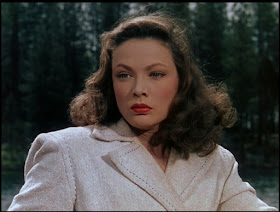 |
| Lavinia Hargraves Masquerade |
In MASQUERADE: Book Two of my Unchained Trilogy series, Bad Girl Protagonist Lavinia Hargraves is the star of the show. She's actually introduced in the first part of the trilogy, Escape. In that story, Lori is a slave girl, and Daniel Taylor the white man who falls in love with her and helps her to escape. Eventually, they have three children, Lavinia being their youngest.
 |
| Gene Tierney as Ellen Berent Leave Her to Heaven |
What drives some bad girl protagonists to be so bad? Sometimes, mental illness can play a role. If Lavinia had lived today, she probably would've been diagnosed with Narcissistic Personality Disorder, which, according to MayoClinic.com, "is a mental disorder in which people have an inflated sense of their own importance and a deep need for admiration. Those with narcissistic personality disorder believe that they're superior to others and have little regard for other people's feelings. But behind this mask of ultra-confidence lies a fragile self-esteem, vulnerable to the slightest criticism."
 |
| Vivien Leigh as Scarlett O'Hara Gone with the Wind |
Lavinia's personality, combined with her actions, make for some rather interesting situations, to say the least. Lavinia joins the ranks of other bad girls in fiction, including Ellen Berent from the 1944 novel, LEAVE HER TO HEAVEN by Ben Ames Williams. Ellen Berent, like Lavinia, is mentally imbalanced. As well as having some unresolved father issues, Ellen is overly jealous for the attention of her husband, Richard Harland. She indirectly causes Richard's crippled younger brother to drown, and then, when pregnant, throws herself down the stairs to cause a miscarriage. Without a baby, she won't have to share hubby's affection. Finally, when it becomes clear that Ellen's adoptive sister Ruth is attracted to Richard, Ellen commits suicide, making her death appear to be murder and framing Ruth for the "crime." Unbelievable! Oh, yeah, it's fiction...
 |
| Undeen Spragg The Custom of the Country |
Another motivation that drives bad women is control. Let's take a look at fiery southern belle Scarlett O'Hara, from Margaret Mitchell's 1936 novel GONE WITH THE WIND. Scarlett's sanity is in tact, but she's a total control freak! Scarlett is determined to marry Ashley Wilkes (the wrong man who's already betrothed to his cousin, Melanie), and after the war, driven to save her plantation, Tara. Scarlett marries once for spite (Charles Hamilton to make Ashley jealous) and twice for money (Frank Kennedy, her sister's fiancé, and then the handsome rogue, Rhett Butler). Scarlett eventually does fall in love with Rhett, after she's been married to him for a while. But when she realizes this, and that a life with Ashley never would've been realistic (after numerous attempts to get him to dump Melanie, before, during and after her marriages), Rhett has had enough and leaves her.
The need for power, status and money drive some bad girls, like Undeen Spragg, the ruthless heroine from Edith Wharton's 1913 novel THE CUSTOM OF THE COUNTRY. Undine is a social climber, who through multiple marriages and divorces, experiences the pleasure of money and aristocratic titles. Eventually, she settles on marrying someone from her hometown. His money is new, and he's actually on her original social level. At this point, Undeen has all that money can buy—yet she wants more. At the end of the novel, she imagines what it would be like to be an ambassador's wife—a position she can never hold due to her divorces.
Bad girls may not endear themselves to readers, but their escapades are certain to keep the pages turning! Who are some of your favorite bad girls in fiction?
Thanks for visiting and have a great week!






